#mount saint michel
Text

Mount Saint Michel, Normandy, France
14 notes
·
View notes
Text
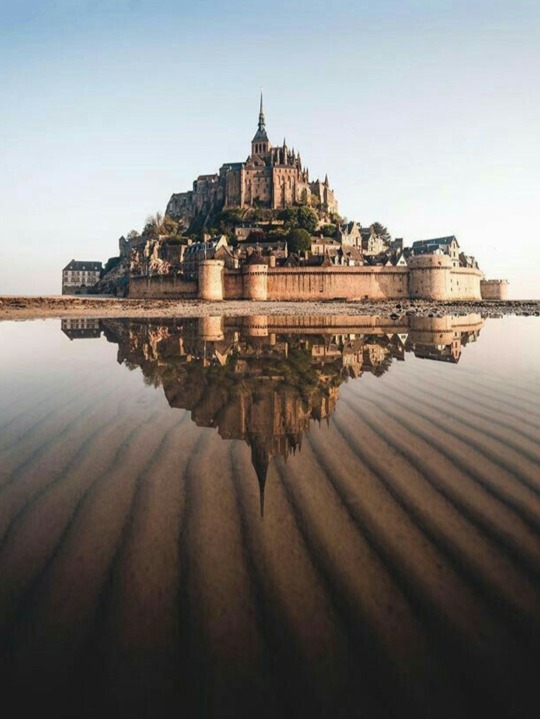
8 notes
·
View notes
Text
I know (hope) Mickey, Donald and Goofy the Three Musketeers is not people’s primary source of french swashbuckler, but in case it is, here are a few historical errors sprinkled here and there.
(not even going to start on the plot because it’s nothing like the book obviously)
- Musketeers are called peasants (or some social equivalent) by Daisy, to explain why Minnie cannot be in love with Mickey. Actually Musketeers were all nobles. Also, Daisy would have been, too, because she’s the lady in waiting of the princess/queen and thus would be one of the highest ranking ladies in the kingdom herself.
- Now obviously modern plumbing, blue overalls for plumbers and electric polishers didn’t exist yet.
- Mount Saint Michael is referenced as a torture place. It was not. I mean it still isn’t. It was a monastery. I’m pretty sure I remember a novel in which they mentionned it as a prison, too. But prisons in monasteries were never torture chambers, and if there had been one case where it was, which I don’t know about, it wouldn’t have been the Mount.
- The opera at the end is the Pirates of Penzance, which premiered in 1879. The Three Musketeers era is under Louis XIII so basically the middle of the XVII (17)th century. On that note, since Pete hears the music on which he sings his king of france song, we’ll count it as an anachronism too (Peer Gynt, Edvard Grieg, 1875), but well every bit of classical/romantic/otherwise music heard in the movie is anachronic. Only counted those canonically heard by the characters.
- Also, but that’s something that’s everywhere even in the original book, the musketeers’ emblematic weapon was not the sword but the musket (that’s... where the name comes from).
- The sword one of the beagle boys uses is a north-african sword, which could mean they are african/arabic mercenaries. However most mercenaries at the time were from Switzerland and Italy.
- Also obviously the fact Minnie is reigning as a princess is doubly, triply... I mean very very bizaar. Because 1) a princess cannot reign. only queens do. 2) at no point in the century in which the Musketeers happens did a woman reign without being the widow of the former king and mother of the newest. That did happen a lot longer than should have legally happened. But Minnie is not with child (or that was left out of the script lol).
- The musketeers being basically the only form of army they have is also not on point at all even if I can understand that an animated pictures movie cannot show twenty different army corps with different uniforms etc, plus it had no place in the plot. Musketeers were, basically, the navy seals of the french army. That means there were also regular marines, plus the terrestrial army and the aviation and the police and...
- The royal palace is shown in the countryside with big gardens. In the Musketeers’ era, the royal palace was in the center of Paris and had no notable gardens.
- The guillotine scene? Well sorry but it’s a century too early, maybe a century and a half.
- Also the whole plan Pete has to get a beagle boy to impersonate the princess and give him the power? Well one couldn’t abdicate that easily, and even now one cannot abdicate in anybody’s favor. If, say, Charles III abdicated today, it could only be in favor of his eldest son William. Here Minnie could only abdicate to her closest eligible relative. The only way it could work would be if Pete was her closest eligible relative. Problem is he is older than her and a boy, so if he had already been eligible at the time she received the crown, due to old succession laws that were valid at the time, he would have been given the crown instead, because being a boy trumped being a closer-to-the-throne girl. So nope. Impossible. But I mean it’s Peg-leg Pete’s plan in a mickey mouse picture so...
Kinda getting sidetracked but I think I’ve covered the subject.
#disney pictures#mickey donald goofy: the three musketeers#disney#mickey mouse#donald duck#goofy d. dawg#minnie mouse#daisy duck#history#the pirates of penzance#peer gynt#mount saint michel#louvres#versailles#alexandre dumas#the three musketeers
24 notes
·
View notes
Photo
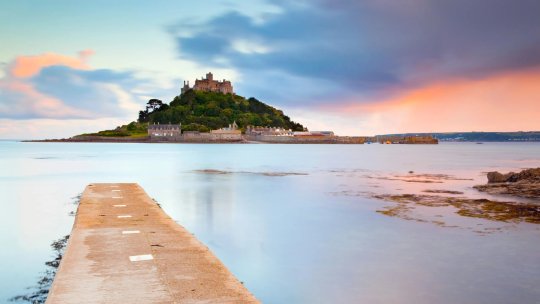

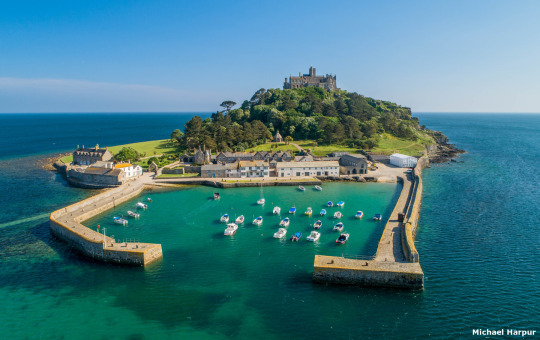

Este es el otro Mount Saint Michel, es el Sain Michael's Mount.
A las dos islas se puede acceder andando y en barco.
La segunda está en el, de momento, Reino Unido.
1 note
·
View note
Text

Sacra di San Michele - ITALIA
#sacra di san michele#saint michael#abbey#abadia#san miguel#mount#montagna#monte#pirchiriano#val di susa#torino#turin#piedmont#piemonte#piamonte#italia#italy#europe#europa
83 notes
·
View notes
Text
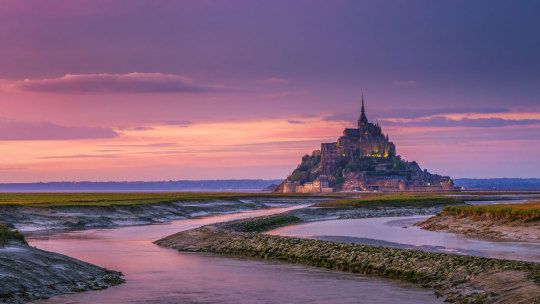

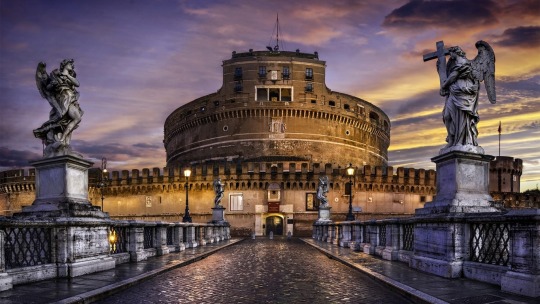


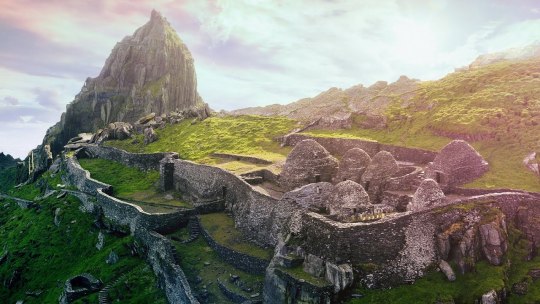


Shrines to St. Michael.
"Mountains figure prominently at the mighty ganglia of the story of Christianity... As Jesus prays atop the holy mountain, the other world intersects with ours as the divine comes down to the human, as the eternal touches the temporal and mortal. And that other world is the ultimate reality, not this one. No wonder that St Michael, ‘Quis ut Deus,’ has his shrines on lofty peaks; no wonder the Celts worshipped on hills and mountains...
The spirit of the Archangel Michael permeates discussion of the world of the Celts—shrines such as Skellig Michael on precipitous mountain-tops in the cold and wet Celtic desert; early connections with the ancient Eastern world; guardianship of Tuscany, Provence, Normandy, and Cornwall; safe-keeping of wanderers and hermits; motifs of spear, sword, and stone; waging of the war in Heaven and the downfall of Lucifer; the communion of the Grail."
St. Michael: Early Anglo-Saxon Tradition, Raymond JS Grant
(1) Mont St. Michel, Normandy, France; (2) St. Michael’s Mount, Cornwall, England; (3) Castel Sant’Angelo, Rome, Italy; (4) Saint-Michel d’Aiguilhe, Le Puy-en-Velay, France; (5) Abbey of San Galgano, Siena; (6) Skellig Michael, County Kerry, Ireland; (7) Sacra di San Michele, Mount Pirchiriano, Turin, Italy; (8) St. Michael’s Tower, Glastonbury Tor, England
#st michael#saint michael the archangel#mont saint michel#st michael's mount#castel sant'angelo#saint-michel d'aiguilhe#skellig michael#glastonbury#glastonbury tor#celtic christianity#celtic#celts
55 notes
·
View notes
Text

As a newly created minor angel in the Celestial Realm, you find yourself caught in the middle of a brewing civil war between the traditionalist faction and the rebels. As tensions mount and battle lines are drawn, you must decide which side to join and navigate the complex politics of heaven. Will you stand with the rebels and fight for change or uphold the status quo with the traditionalists? The choices you make will determine your fate and the fate of the Celestial Realm.

Seraphim is an interactive story inspired by Christian theology. In this story, all colors/sexualities/genders are treated equal and magic undoubtedly exists.This story will be available on pc and mobile and it’s entirely text-based. It’s currently in development and it will be released chapter by chapter.
Rating: 18 + for graphic depictions of violence and death, skippable explicit sexual content, torture & executions, and coarse language.
Genres: Fantasy, Romance, Drama, Adventure
Demo: To be Added...
Asks: Check my Guidelines

Customize your name, looks (in both angel form and human form), personality, skills, and independent gender and pronoun selection.
You will also be able to choose if you side with the traditionalist faction (with Michael/Michelle) or the rebels (with Lucifer/Lucielle).
Choose your weapon. Are you a powerhouse or do you rely more on finesse?
Select your magical specialty.
There are seven romanceable options. You can select the gender of all of them.

Michael/Michelle, The Regent
Race: Seraphim
Looks (of Human form): Dark brown skin and dark brown eyes. Black hair is slightly curly at the ends and it's cut short. Muscular and extremely tall and bulky.
Description: As the Regent, they're the official leader of the Celestial Realm; they lead the angels in God’s absence. The Regent is often described as authoritarian, prideful, responsible, hard-working, and assertive. They are also the leader of the conservative/traditionalist’s faction of Heaven.
Lucifer/Lucielle, The Morning Star
Race: Seraphim
Looks (of Human form): Waist-length, long, straight platinum blonde hair, fair skin, jade green eyes. Tall, lithe, and slender physique.
Description: They are the leader of the rebel faction of Heaven. Charming and silver-tongued, they are darkly alluring and dangerously seductive. To you, they are a mystery. To them, you are an open book. It is unwise to catch their interest, lest you succumb to their hunger.
Simeon/Simone, Regent's Right Hand
Race: Seraphim
Looks (of Human form): Dark brown wavy hair, cyan blue eyes, and dark brown skin. Tall, slender and lithe physique.
Description: Even-tempered, perceptive, and amiable, S is the most well liked and popular of the Seraphim. They're a close friend of both M and L.
Callis/Charmaine, The Innocent Ingenue
Race: Angel
Looks (in human form): Golden eyes, light brown skin, and ash blonde hair. They are muscled, short, and bulky.
Description: Gentle, kind, and easily flustered. They are your nestling and childhood friend.
Belphegor/Belle, Sloth Demon
Race: Sloth Demon
Looks: Sky blue skin, black eyes, short black hair. Black ram horns, navy blue feathered wings, and a scaly pronged tail. Short, lithe, petite physique.
Description: You were ordered to destroy them, but you failed. Ever since then, for some reason, they seemed obsessed with you. They frequent your dreams and seek to capture your heart and make you fall.
Ellis/Elaine, The Saint/Saintess
Race: Human
Looks: Wavy Sky blue hair, grey eyes, and fair skin. Short, petite. If female, a large bust and waist-length, long hair. If male, shoulder-length hair.
Description: In the Mortal World, they are hailed as the Saint/Saintess. Unfortunately, they serve a different god than your own. You are ordered to discredit them, to hinder the power of this false god, but the more you get to know them, the more you can't help admire them. They're clever, resourceful, and devoted. They're everything an angel should be.
Abaddon, Chaos-Bringer
Race: Archdemon
Looks (human form): Hetero-chromatic eyes–one blue, one purple, dark brown skin, and spiky ebony black hair. They have a tall and slender physique.
Description: They are not the most well-liked among demons, but that doesn’t appear to bother them. They have a tendency to push buttons and bring chaos and drama wherever they go. They are charismatic and mischievous, yet biting and cynical. Quick-witted and wickedly clever, they are more powerful than they seem and are keen to use that power to cause maximum suffering and destruction.
#interactive fiction#cyoa#twine game#interactive story#angels and demons#angels & demons#angels#demons#lucifer#lucifer morningstar#belphegor#seraphim if#no demo#twine story#interactive novel
882 notes
·
View notes
Text
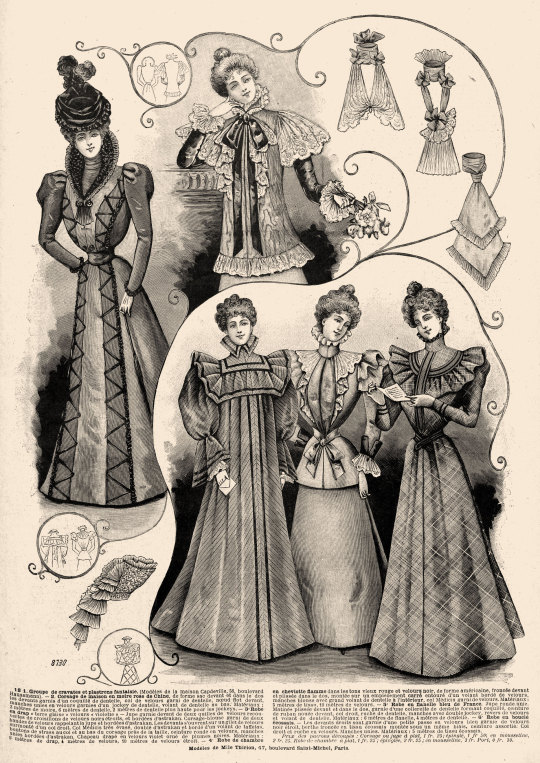
Le Petit écho de la mode, no. 4, vol. 20, 23 janvier 1898, Paris. 12. (1) Groupe de cravates et plastrons fantaisie. (Modèles de la maison Capdeville, 58 boulevard Haussmann). (2) Corsage de maison en moire rose de Chine. (3) Robe en drap. (4) Robe de chambre en cheviotte flamme. (5) Robe en flanelle bleu de France. (6) Robe en bouclé écossais. (Modèles de Mlle Thirion, 47, boulevard Saint-Michel, Paris.) Ville de Paris / Bibliothèque Forney
(1) Groupe de cravates et plastrons fantaisie. (Group of fancy ties and bibs.)
—
(2) Corsage de maison en moire rose de Chine, de forme sac devant et dans le dos les devants garnis d’un coquillé de dentelle col de velours garni de dentelle, nœud flot devant, manches unies en velours garnies d’un jockey de dentelle, volant de dentelle au bas
(2) House bodice in Chinese pink moire, sack-shaped front and back, fronts trimmed with shell lace, velvet collar trimmed with lace, flowing bow in front, plain velvet sleeves trimmed with a jockey of lace, lace flounce at the bottom
Matériaux: 3 mètres de moire, 6 mètres de dentelle, 2 mètres de dentelle plus haute haute pour les jockeys.
—
(3) Robe en drap "terre glaise" velours "violette" — Jupe garnie devant de deux quilles de velours recouvertes de croisillons de velours noirs étroits, et bordées d’astrakan. Corsage-blouse garni de deux bandes de velours rappelant la jupe et bordées d’astrakan. Les devants s'ouvrent sur un gilet de velours surmonté d’un col droit. Col Médicis très évasé, doublé d’astrakan et bordé d'un volant de taffetas boutons de strass au col et au bas du corsage près de la taille, ceinture ronde en velours, manches unies bordées d’astrakan. Chapeau drapé en velours violet orné de plumes noires.
(3) Dress in “clay” cloth and “purple” velvet — Skirt trimmed in front with two velvet keels covered with narrow black velvet lattices, and edged with astrakhan. Blouse-bodice trimmed with two bands of velvet reminiscent of the skirt and edged with astrakhan. The fronts open onto a velvet vest topped with a straight collar. Very flared Medici collar, lined with astrakhan and edged with a taffeta ruffle, rhinestone buttons at the collar and at the bottom of the bodice near the waist, round velvet belt, plain sleeves edged with astrakhan. Draped purple velvet hat decorated with black feathers.
Matériaux: 6 mètres de drap, 4 mètres de velours, 10 métrés de velours étroit.
—
(4) Robe de chambre en cheviotte flamme dans les tons vieux rouge et velours noir, de forme américaine, froncée devant et plissée dans le dos, montée sur un empiècement carré entouré d’un volant bordé de velours, manches blouse avec grand volant de dentelle à l’intérieur, col Médicis garni de velours.
(4) Flame cheviotte dressing gown in old red tones and black velvet, American shape, gathered in front and pleated in the back, mounted on a square yoke surrounded by a ruffle edged with velvet, blouse sleeves with large ruffle of lace inside, Medici collar trimmed with velvet.
Matériaux: 5 mètres de tissu, 10 mètres de velours.
—
(5) Robe en flanelle bleu de France. Jupe ronde unie. Matinée plissée devant et dans le dos, garnie d’une collerette de dentelle formant coquillé, ceinture de ruban nouée devant, col droit, ruche de dentelle, manches avec double jockey, revers de velours et volant de dentelle.
(5) French blue flannel dress. Plain round skirt. Pleated matinee front and back, trimmed with a lace collar forming a shell, ribbon belt tied in front, straight collar, lace ruffle, sleeves with double jockey, velvet cuffs and lace flounce.
Matériaux: 6 mètres de flanelle, 4 mètres de dentelle.
—
(6) Robe en bouclé écossais. — Les devants droits sont garnis d’une petite passe en velours bleu garnie de velours noir étroit, berthe froncée en tissu écossais montée sous un même biais, ceinture assortie. Col droit et ruche en velours. Manches unies.
(6) Scottish loop dress. — The straight fronts are trimmed with a small blue velvet pass trimmed with narrow black velvet, gathered berthe in tartan fabric mounted under the same bias, matching belt. Straight collar and velvet ruffle. Plain sleeves.
Matériaux: 5 mètres de tissu écossais.
#Le Petit écho de la mode#19th century#1890s#1898#on this day#January 23#periodical#fashion#fashion plate#description#Forney#dress#gigot#dressing gown#collar#Modèles de chez#Maison Capdeville#Mademoiselle Thirion
23 notes
·
View notes
Note
23 and squirrelflight
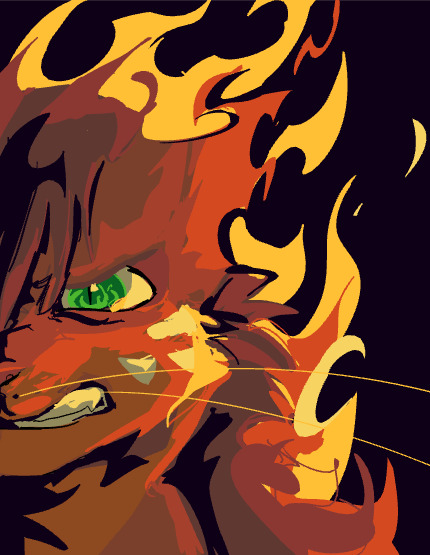
Went into this one without a plan lol
#sorry in advance for the amount of aphex twin on this playlist#my art#warrior cats#squirrelflight#ask#anonymous
171 notes
·
View notes
Text

St Michael's Mount (Cornish: Karrek Loos yn Koos) meaning "hoar rock in woodland" is a tidal island in Mount's Bay, Cornwall, England, United Kingdom. The island is a civil parish and is linked to the town of Marazion by a causeway of granite setts, passable (as is the beach) between mid-tide and low water. It is managed by the National Trust, and the castle and chapel have been the home of the St Aubyn family since around 1650.
Historically, St Michael's Mount was a Cornish counterpart of Mont-Saint-Michel in Normandy, France, which is also a tidal island, and has a similar conical shape, though Mont-Saint-Michel is much taller.
#architecture#st michael's mont#cornwall#england#medieval#city#tidal island#castle#stone building#marazion#church#landscape#history#tourism
11 notes
·
View notes
Text
Art in HotD - 1x05 “We Light The Way”
(more art in Westeros) - (more art in HotD)
(Make sure to click through, these images are BIG)
There’s no doubt about what makes the meaty part of this episode: Corlys’ art collection. But first, a good panoramic look at High Tide:

Hard not think of Mont Saint-Michel. Does this make the Stormlands Fantasy Normandy? Maybe, if maritime pines grew there. On the other hand in this very episode Larys explained to us that “natural habitat” is an elastic concept on Planetos (which honestly? is consistent with the magical seasons). ETA: The actual filming location is indeed St. Michael’s Mount in Cornwall, historically hosting an abbey founded by benedictine monks coming from… Mont Saint-Michel. (Thanks to Ashaya of History of Westeros and @salty-wench for pointing this out to me!)
But it’s the inside that’s the real treat. We saw a glimpse of it in episode 2, when Corlys and Daemon join forces to fight at the Stepstones.

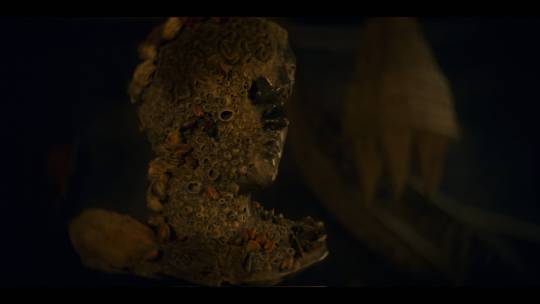
That bronze head covered in coral and sediments makes a clear connection between the Velaryons and the sea they tied their house’s heritage to. Same for what looks like the skull of a deep sea fish on his desk. But they are also bizarre and unique items; let’s put a pin on that.
The great hall in High Tide gives the impression of being spacious and airy, despite being full of items collected by Corlys in his travels. The architecture is very spartan, with some painted decoration on the window arches, that together with the teal walls prevent the room from feeling too austere. I’m also a bit at loss with the diamond texture on the pillar capitals; they don’t really look like any historical style I can think of, though the diamonds have been used in the renaissance for civilian as well as military architecture, just not on capitals.

A good look at the Driftwood Throne; a piece of lore that wasn’t mentioned in the episode was that it was gifted to the Velaryons by the mythical sea deity the Merlin King. It would be interesting to know whether it was the Velaryons who decorated the wood with their heraldic seahorse or if the story goes the other way around - they adopted the seahorse because it was already there? I am leaning towards the former.
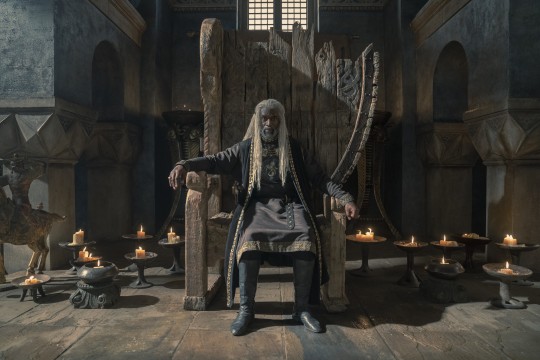
On the bottom left you can also see a mid sized statue of what looks like an Asian warrior, reminiscent of both the terracotta soldiers and of traditional Mongolian iconography. Does this represent an inhabitant of Yi Ti?
Another statement piece besides the throne is the model of the castle on the left side of the room:
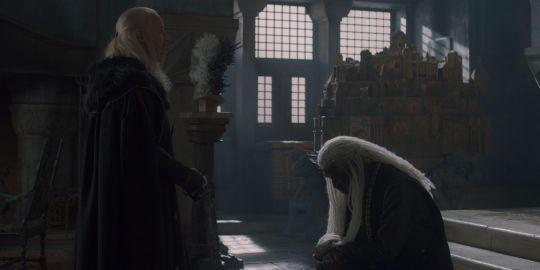
Not gonna lie, during my first viewing I took note of it and I assumed it was a model of High Tide itself, but the actual castle is much smaller. The architecture is also distinctly different from the one in Viserys’ model of Valyria, so it isn’t a representation of the Velaryons’ ancestral land. A possibility is that it is actually Driftmark, so Corlys is watching over both his castles at the same time - and most of all, he is displaying them both. It’s important to note that unlike Viserys’ miniature, this model is meant to be seen by whoever is coming to meet the Lord of the Tides. However, this doesn’t really match the description of Driftmark as dark and cramped, so I’m making a wild guess and saying it is actually a project for the future expansion of High Tide, as the architectural style seems to match, as well as the hilltop silhouette. The model also seems to be made of wood, which was the preferred material for this kind of item back before modern lightweight alternatives and 3D renderings. Note also the statues holding the table, an iconography with its roots in antiquity and that took hold again during the Renaissance before taking a decidedly racist turn shortly after (a huge number of architectural elements but also furniture etc. especially from the 17th and 18th century depict black men in that position, often with exaggerated, grotesque features).
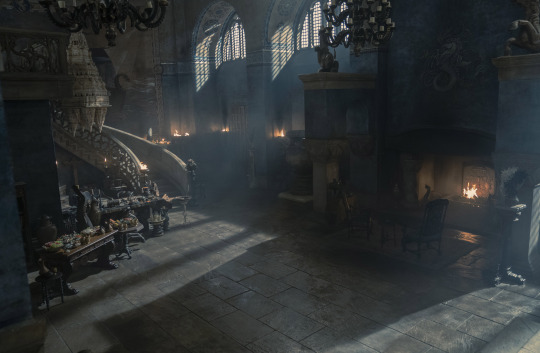
It wouldn't surprise me if the big seashell near the throne was custom made for High Tide especially because of the impeccable color coordination, but I'm not so sure. Something that definitely was commissioned is the huge fresco depicting a ship behind the staircase (why oh why is it behind a staircase??? Corlys you didn't think *this* through). The figurehead represents the titular Sea Snake Corlys' ship gets her name from, preceded by dolphins (both in classical and Medieval/Renaissance iconography a symbol of good fortune for seafarers, and also of speed and intelligence) and it is also going in the direction of the sun, which is interesting in the context of this quote from Fire & Blood:
As for Lady Alys Westhill, born Elissa of House Farman, where her adventure ended we cannot say. The Sun Chaser vanished into the west, still searching for the lands beyond the Sunset Sea, and was never seen again.
Except…
Many years later, Corlys Velaryon, the boy born on Driftmark in 53 AC, would take his ship the Sea Snake on nine great voyages, sailing farther than any man of Westeros had ever sailed before. On the first of those voyages, he sailed beyond the Jade Gates, to Yi Ti and the isle of Leng, and returned with such a wealth of spice and silk and jade that House Velaryon became, for a time, the wealthiest house in all the Seven Kingdoms. On his second voyage, Ser Corlys sailed even farther east, and became the first Westerosi ever to reach Asshai-by-the-Shadow, the bleak black city of the shadowbinders at the edge of the world. There he lost his love and half his crew, if the tales be true…and there as well, in Asshai’s harbor, he glimpsed an old and much weathered ship that he would swear forevermore could only have been Sun Chaser.
Is this fresco both a celebration of Corlys' famous voyages and a declaration of intent - that someday he, or another Velaryon, will go "west of Westeros" the way the legend says Elissa Farman did? Either way, it's as much of a statement piece as the storytelling columns in the Great Hall in King's Landing, except less martial and more aspirational. You can glimpse a bit more of the fresco in some pre release featurette from HBO that I didn’t have the time to track down, which shows the ship is also accompanied by actual sea snakes, and that the painting overlooks what’s basically an altar with the skulls of the Velaryon ancestors wearing oblong helms, clearly representing the ground (well, technically the sea) upon which the house stands.
>
House Velaryon as envisioned by Corlys, however, doesn’t dwell on the past; it is projected towards growth and discovery. There seem to be also some little monochrome scenes in the circles painted into the framing of the bigger fresco, but not even high res production stills are able to show what exactly they are depicting.
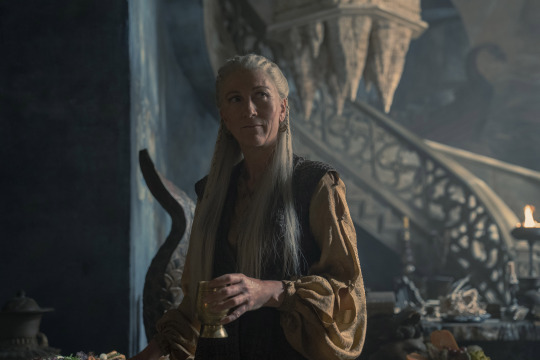
On to items that have been collected rather than commissioned: lots of sea and horse imagery, but no straight up seahorse save for one where the peculiar bend of the tail makes me suspect it had a functional purpose, possibly as an oarlock. There are also items that do not relate directly to the Velaryon heraldry, like that stone element hanging from the ceiling that reminds me of the steeples of Khmer temples like the ones in Angkor, Cambodia. Or what might look like an astronomical tool, relevant for a seafarer, but also interestingly held by serpents, which might indicate more obscure, occult uses (and as the quote above reminds us, Corlys allegedly sailed as far as Asshai). There's a random wooden statue representing a human figure, precious pottery, etc. There's also, notably, the Crabfeeder's mask, which makes me wonder how many of Corlys' treasures were bought or traded and how many are spoils of battle.
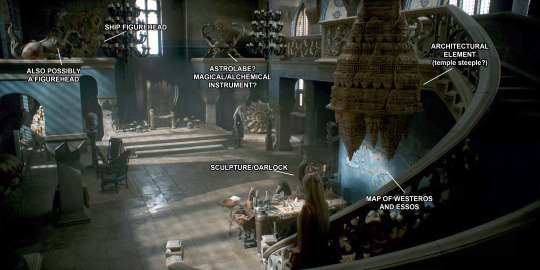
What these items make when grouped together isn't so much a museum or private art collection, as much as a Wunderkammer, or cabinet of wonders. It's important to note that in the eras HotD draws from - basically the late Middle Ages with some tentative leap towards the Renaissance - the notion of art and its value was different than it is now. The way we conceive of art today owes a lot to the Romantic movement and its idea of art as the expression of human emotion - and of individual human genius. Before that, with various degrees of nuance, art was mostly a means to an end, and the artist was generally seen as a glorified craftsman (sometimes craftswoman) whose intellectual and personal contribution began and ended at the formal, technical stage of execution (again: there was wiggle room for this, and increasingly heated debate on figurative artists’ intellectual worth, but I digress). Which is why the Wunderkammer often mixed what we now consider actual, reputable art (or archaeology) with things that were valued just because they were weird and unique, like stuffed exotic animals, weirdly shaped pearls or seashells and whatnot, complex machinery, biological specimens going from the bizarre to the macabre. Cabinets of wonders have often been the starting point for the construction of modern museums, but Westerosi culture is still very far away from conceptualizing museums or private art collections in the modern sense, however they have the right mindset to start building Wunderkammern.

In a way, Corlys is the closest thing Westeros has to a Renaissance prince right now, because he claims ancient nobility but he's also a self made man, whose influence relies on a wealth built on trade rather than on the ownership of land or natural resources. And, like a Renaissance prince, he has a keen understanding of the use of art and decor as a means to communicate what he and his family are, what they were and what they want to be.

I thought High Tide would take over all of this week's post BUT we have at least a couple of tidbits from the Red Keep. We get a nice look at Alicent's quarters, and while the walls are dominated by the usual dragon orgies, I spotted that little aedicule near the window. Unfortunately we can't see what it contains, but my money would be on some little painting or icon relating to the Seven, a little niche for Alicent's devotion amongst the aggressively pagan wall art. It would be in line with the thinly veiled Catholic references the Faith is built upon, as it's pretty common for Catholic devotional paintings or statues (especially of saints or the Virgin Mary) to be housed in aedicules. It's a small thing, but I'm very curious to see whether and where the production design slips Faith iconography in the background, as it seems to be one of the main divides between the Greens and the Blacks.

Also, peep the dolphin shaped table legs, a popular motif during the Renaissance in general but, besides the meanings we've seen in relation to Corlys, also traditionally associated with nobility and faithfulness, hence a fitting iconography for a queen consort.
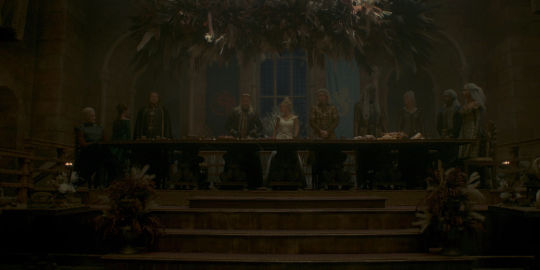
Last but not least, this isn't artwork per se, but it's hard not to see a callback to Last Supper imagery when it comes to the high table at the wedding feast - but rather than Leonardo's famous painting I got reminded of a slightly older iconography which explicitly singled Judas out. Which isn't to say Daemon is literally the Judas in the scenario, especially if we take Rhaenyra as the "Jesus" of the scene - she even has a halo/crown created by the outline of the Iron Throne when she’s seated... - but he is definitely a disruptor. Though not as disruptive as Alicent, the real odd one out here, arriving late and dressed in green as she joins a table that's basically composed of the future Blacks. Ironically, from her point of view it's Rhaenyra who is the Judas in the picture.
(also high res production stills show us some more details about the reliefs on the Great hall columns - yeah that's indeed a Targaryen shield there in the upper right. Now, if only I could make out what's on the shield more to the left...)
#art in hotd#house of the dragon#hotd meta#hotd 1x05#fire and blood#art history#this is so long........ i'm very sorry i even tried cutting stuff out#blame it on famous hoarder corlys velaryon#renaissance#wunderkammer
95 notes
·
View notes
Text
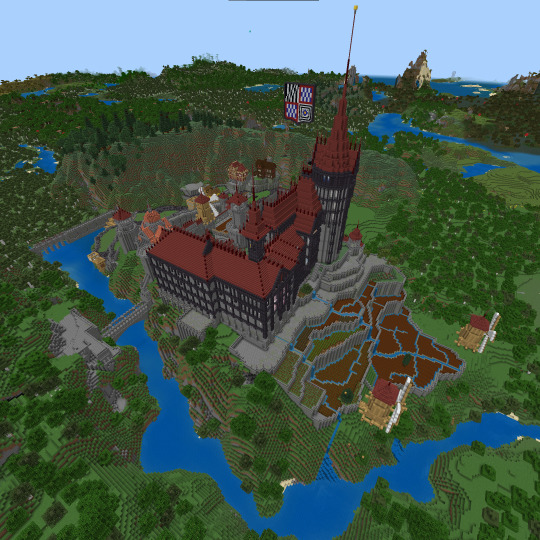
🏰Build Process & Guide💁♂️
I'm making this in-depth post about my process, @lordoftablecloths asked how i planned the build and ill make this a separate post for all interested, this might be pretty long so it'll be under the cut, i'll add pictures where i can to help explain :3 will contain mostly explanations why i did what i did with a few technical tips mixed in.
I • Introduction & Inspiration
I'm going to try and structure this like a guide from the bottom up on how i made my castle build. let it be known that the order I've presented here isn't the exact order i built it in, and you don't have to follow exactly either, I'm choosing an order that i hope makes the most sense. whether you're planning a castle in creative or survival i hope this is useful. as for what inspired the look of the castle, its hard to pin down anything exactly, i love the look of places like Neuschwanstein Castle and Mont-Saint-Michel to give some basic examples, i recommend looking around Wikipedia (and the rest of the internet) for examples of existing churches castles fortresses etc around the world to draw from, sometimes you can even find floor plans and architectural drawings etc on google images
I HIGHLY recommend you build with XYZ coordinates enabled! even in survival it can help with your builds, it can be enabled in the settings on world creation or by using the command:
/gamerule showcoordinates true
II • Picking a Build Location
I started a new world with normal settings creative mode and cheats (i also use world-edit but won't be going over that in this post as i barely understand it myself lol) basically just fly around your world until you see some interesting looking geography, a certain biome, anything that brings you some inspiration
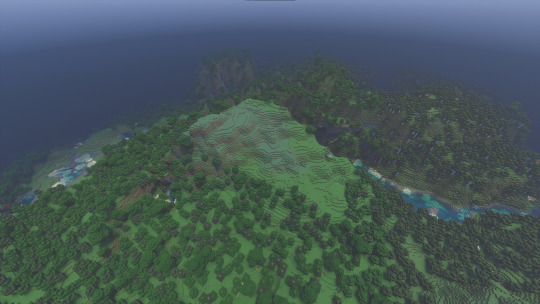
this castle mount i found is isolated by itself in a small valley between two large ridges and a river, thus i thought a castle would be the perfect thing to build here, there's plenty of room for a town as well
III • Terraforming & Laying Foundations
when starting a foundation on a hill/slope i try and find a good flat area to start clearing, you can shave off a few layers to get a level starting area, what to then do to get a terraced look is simply stand on your top level, sneak to the edge, and while keeping your Y level look straight down and fill outwards as far as you can reach, this will make 4 block high walls; exact heights are always up to you, treat every number like a suggestion and build what YOU think looks good! the number of tiers is also your choice, multiple is nice if you want multilevel walkways implemented into any steep area you want to be more accessible.


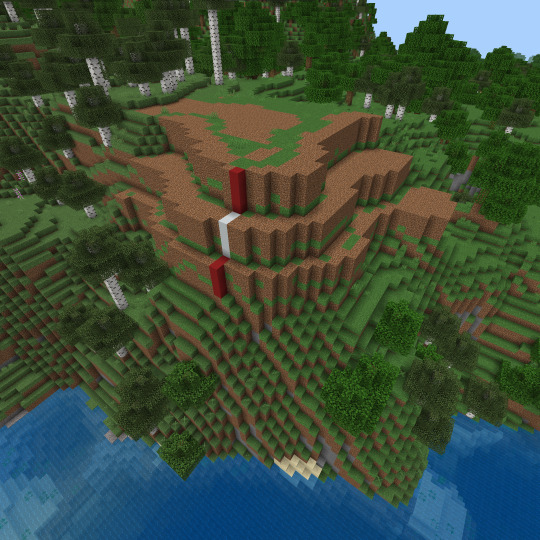

and dont forget to extend your build material all the way into the ground!

IV • Central Core & Courtyard
I think the very first thing i put on the mountain was the circle which would eventually be the main tower, acting as a main core for the building containing the main starway and a throne room at the top. I'd suggest having multiple intersecting shapes for your base, as you can build each of those shapes up in and out in separate ways the higher you go, which is pretty much the philosophy i had for this build, just remember to account for multiple stairways if you separate those shapes higher up.

i figured there should be some sort of tiered system of courtyards and walls since the hill has a natural gentle(ish) slope on the west. if you have the space for it i recommend filling in some green spaces for your castle residents, don't be afraid to have a steep cutoff like in the above image, you can put a castle wall or structure there later. for me, i wanted it to feel like a hike up to the castle through a winding path of gates, stairs, courtyards, and green areas

The hall with the rainbow windows was the first enclosed room i built, essentially a chunk of the floorplan reserved for a kind of reception space/grand entrance, once you've got a basic foundation down a small building like this can help you get a grasp of what kind of style/materials the rest of the castle will have. this is where i decided the castle would consist of stone brick foundations, smooth stone walls, a band of bricks on each floor; this can be super helpful while building inside and outside, i also like how it looks.
V • Main Building Facade
since i didn't want this entire build to be a blob of stone bricks i decided to add a decorative facade on the outside of the main keep, the idea is to have more blackstone near the top, to emphasize that the upper parts contain more important... stuff :P

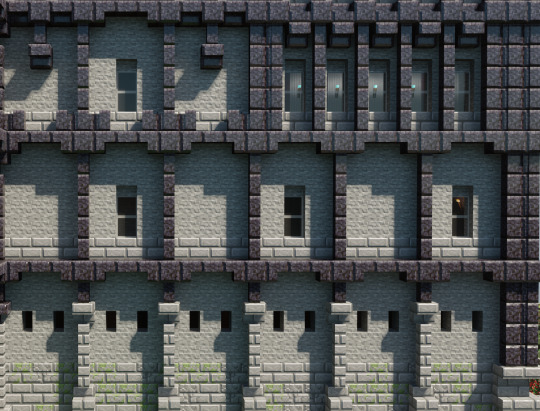
these are built more or less outside of the main stone walls (except for some window protrusions) this means the interior rooms won't have to have one weird wall of blackstone, as i wanted the inside of the castle to have relatively plain smooth stone rooms
VI • "Defensive" Walls & Extra Foundations
castles need some sort of protection against people wandering in, right? the placement of these outer walls was kinda random, i just tried to enclose some courtyard spaces without going out too far to keep the walls a reasonable height

the way most of the outer walls were built was i started with a one block wide guide, making sure i didnt cut off any diagonals so that when built up there would be a small but navigable corridor within them (see below) this way people/guards etc. can move about the lower areas of the castle complex without being seen. I tried to keep most of the walls like this 3 blocks wide with a step out to 5 blocks at the top to account for a 3x path with walls/battlements on both sides

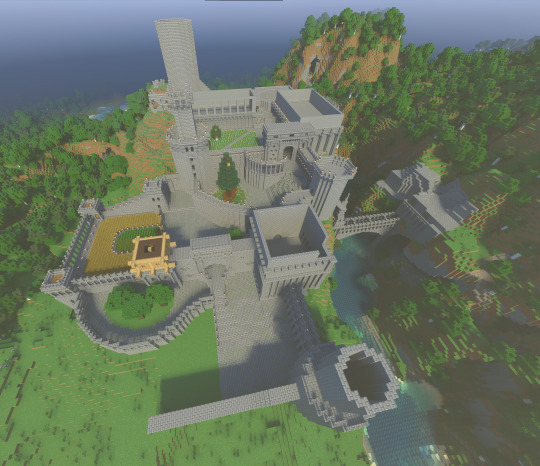
i also added towers at junctions to sort of act like small hubs (useful for stairways, ladders, guard barracks, defensive supplies and buildings etc.
VII • Other Structures
a castle build can be more than just a keep and some walls, some supporting structures are:



the windmill(s), if the people here are growing grain they must have somewhere to mill it, right? of course all you need to actually do that is a crafting table, stuff like this also won't move (unless you use a mod like technic, but bedrock users are SOL for mods like that afaik) but i like to add elements of realism into my builds, suspend your disbelief!
the "library", originally this was going to be a sparring arena, then a temple, then a library, but as of now there's a much better stocked library in the central keep, i'm trying to think of what to turn this into,
the alchemist's tower, a detached tower containing a brewing lab along with a nether portal and some ingredient storage. only accessible via a small bridge, if i ever expand the dungeons or construct a sewer system i'll consider connecting it through a new stairway in here 🤫
VIII • Farms & Irrigation
this is the first field of crops i built for the castle (intended to be private and for the castle only), very simple with some covered water troughs for irrigation, i didn't plan the stepped farms until much later so this will probably get changed without completely redoing it, maybe turned into a greenhouse with farmed flowers

the newer farms cover much more area and have more variety, as well as a more organic looking irrigation system, these might be extended even further at some point to be a food source for the whole area.

there are small channels of waterlogged stair blocks i've kinda snaked through the farmland to make quarter block wide water channels, my idea is that this castle sits on a (possibly mystical) spring which feeds the fresh water needs of the castle complex and town (aqueducts may appear in the future)

IX • Outer Wall Details
since having nothing but flat walls isnt very interesting, i'll show some ways to give them more... visual texture? interest? either way.

you can really just stick a layer of arches or even simple columns over a flat wall and itll look 10x better
i recommend stair and wall blocks mainly for this, if you're building in wood you can use trap doors to add just a little more to an arch

X • Floor Appearance & Hierarchy
one of the most important things to decide when i start a build is what floor height i want to have, i try to keep each floor in the castle the same height for consistency. below i have an example of six floors with different block heights

I always try to have each floor made of distinct layers (the stone brick band helps me remember where the floor block is supposed to be) the way i like to do it is as follows (top to bottom):
[1 Block] floor, solid block, this is the floor of the next level
[1-3 Blocks] ceiling, i like to use stairs and slabs so you dont see the bottom of the next floor up, but you can decide if you want that to show or not, using single lines of slabs can look like wood beams
[2-5 Blocks] walls and windows, the main section of the wall, solid
[1 Block] guide layer made of a different material, or just use the same throughout, this should be where your legs are
[1 Block] floor, solid block, you'll walk upon this
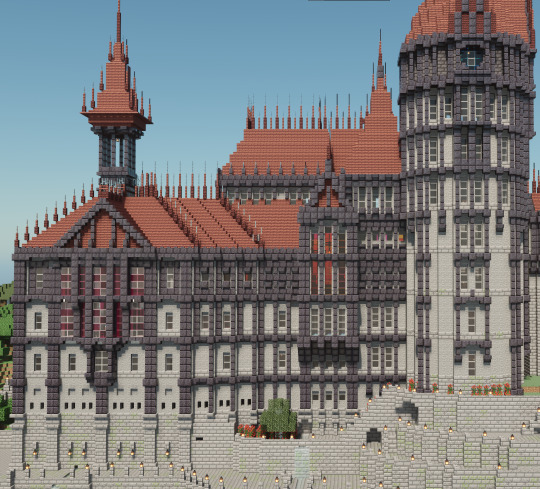

about the hierarchy, thats just relating to the fact that i didnt want (too many) glass windows in the dungeon sections of the castle, i wanted it to feel cold, grimy, and drafty ya know? so the lowest levels have a few iron barred windows as well as a bunch of slit windows made using stair blocks, there are also more and more windows the higher up you go. There are some windows that extend out each floor as well
XI • Interior Details
The lowest parts of the castle consist of stonebrick halls, storage rooms, connections to the outer wall corridors, and possibly forgotten paths to the depths... as stated earlier i try to have a floor material, and a wall+ceiling material
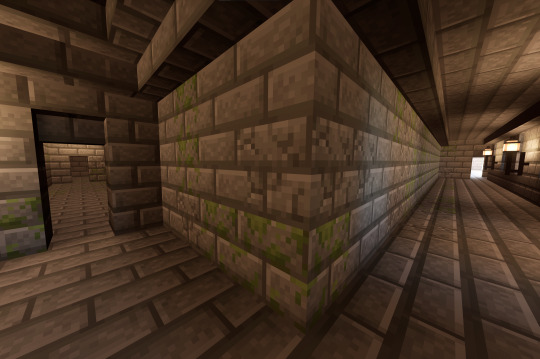
above: undercroft level, steel bar windows, stone brick, dingy
below: mid-level central keep (facing south) the windows here are glass, but still small, wood floors throughout, upper floors get the benefit of more natural light


pictured above is the central spiral staircase, it does take up quite a bit of the floorspace, but the wide and easy slope makes it easier to navigate so i think its worth it
the most fantastical details are currently in the ballroom, library, and throne room but im running out of picture slots so onto the next category
XII • Spires & Roofing
all of the roofing (aside from some detailing on the entrance hall) is mangrove wood, and i recommend choosing one roofing material to have throughout, though you'll see here that i'm using red nether brick walls, why? Well fence blocks don't connect to wall blocks, and iron rods won't connect to fence blocks (if this is bedrock only or something let me know..) i find it really useful to add these alternating stacks of those blocks to make quite sharp looking points along the ridges of the roof. i recommend trying out whatever different color palettes you can with the blocks we have in-game

the heights of the stacks also go up the higher (and thus farther away) you go, meaning the highest ridges will have 3 of each block stacked, like 3,3,3 and 2,2,2 instead of the 1,1,1 seen in the foreground above
XIII • :3
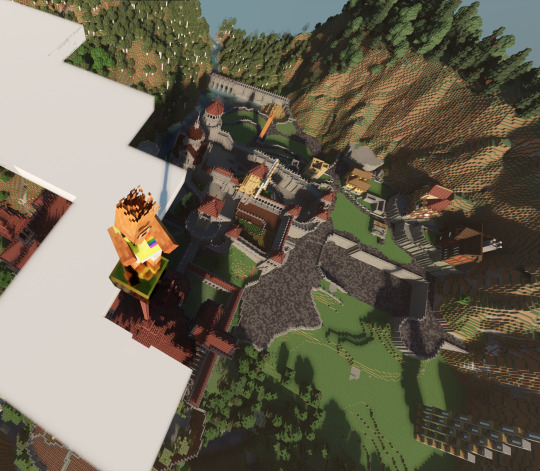
thank u for coming to my ted talk! i might update this post to add some clarity if i need to, hope you enjoyed it if you made it this far. I had fun writing it up, might do more posts like this in the future.
#mineblr#minecraft screenshots#minecraft#minecraft build#minecraft wip#minecraft tutorial#minecraft tumblr#castleburgh
16 notes
·
View notes
Text
Iconic Mont Saint-Michel Abbey celebrates 1,000 years
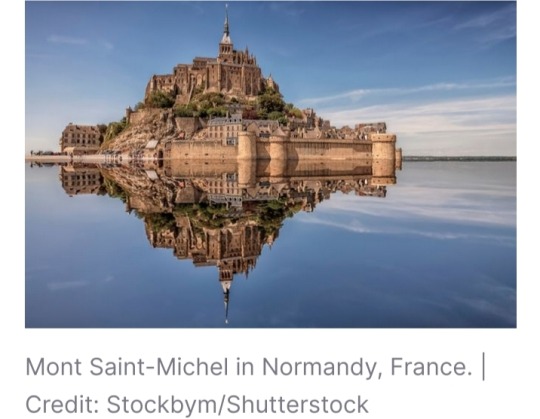
By Solène Tadié
13 June 2023
It was exactly a millennium ago that the first stone of the abbey church of Mont Saint-Michel in French Normandy was laid.
The monument that the poet Victor Hugo called the “Khéops of the West” has since become one of the highest symbols of French Catholic identity and one of the most important pilgrimage sites in the world, with more than 3 million visitors a year.
This important anniversary will give rise to a number of celebrations that will continue through the fall of 2023.
Standing on relatively inhospitable terrain, enthroned on a rocky islet less than a kilometer in diameter, surrounded by a vast sandy plain subject to the vagaries of the tides, the UNESCO World Heritage Site has stood the test of time, offering itself as a spectacle for dozens of generations to see.
Indeed, the history of this place of prayer and pilgrimage was as precarious and tumultuous as its surroundings.
While the construction of the present abbey church dates back to 1023, a first church dedicated to St. Michael the Archangel is said to have been built as early as 708 on the mount, then known as Mont-Tombe.
According to “Revelation,” the oldest text reporting the context of the abbey’s construction (written around the beginning of the 11th century), St. Aubert, then-bishop of Avranches, was visited three times in a dream by the archangel, who instructed him to erect a sanctuary in his honor on the summit of the site “so that he whose venerable commemoration was celebrated at Mont Gargan [the first great shrine dedicated to the Leader of the Celest Army, in the Puglia region of Italy] might be celebrated with no less fervor in the middle of the sea.”
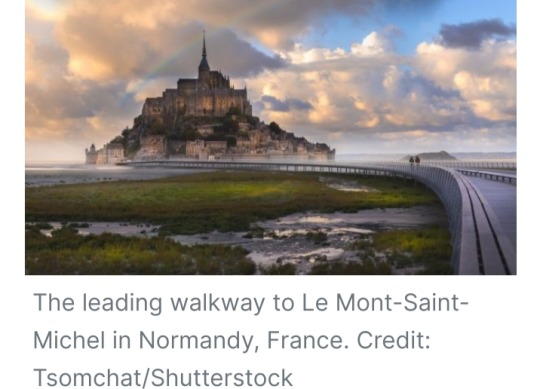
St. Aubert undertook the building of a first church with the capacity of about a hundred people, consecrated in October 709 and given the name Mont-Saint-Michel-au-péril-de-la-Mer.
The prelate installed 12 canons there, responsible for praying the Divine Office and welcoming local pilgrims.
The canons were replaced in the 10th century by Benedictine monks at the behest of Richard I, Duke of Normandy, who had little taste for the canons’ opulent lifestyle.
In 1023, the order undertook the construction of the abbey church we know today, based on three rock-cut crypts and the former chapel.
This ambitious project marked a decisive step in the international outreach of the site, where miracles abounded as the flow of pilgrims from all over Christendom expanded.
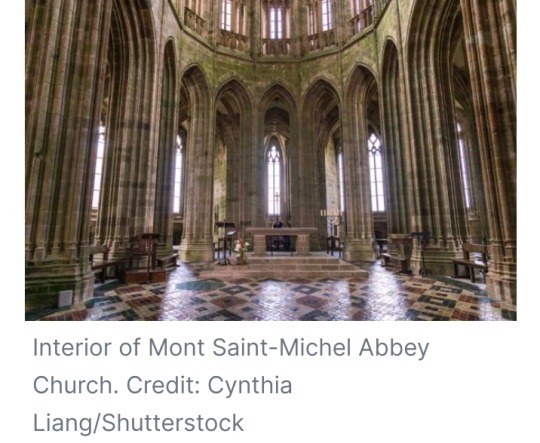
“This edifice is like Noah’s ark laid over the crypts,” said François Saint-James, a guide and lecturer at Mont Saint-Michel, in an interview with Le Devoir newspaper, underlining the architectural prowess required for this medieval project.
“It was a time when France was covered with a white cloak of churches, as a monk from Cluny once wrote. You have to imagine the gigantic scale of the work.
The granite blocks were cut on the Chausey islands, 34 kilometers from here.
Caen stone, a soft, light stone that’s easy to carve, was used. ... When, in the midst of the Hundred Years’ War, the Romanesque choir collapsed, it was rebuilt in flamboyant Gothic style.”
While the abbey’s architectural evolution continued uninterrupted until the 19th century, one of its highest points was the construction of “La Merveille” (The Wonder) in the 13th century, a jewel of Norman Gothic art.
It consists of two buildings on three levels, supported by high buttresses, with a cloister and refectory, 80 meters above sea level, beneath which were built an almshouse, a storeroom, and guest rooms.
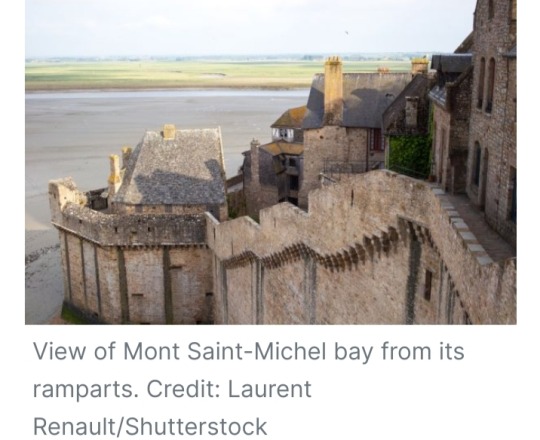
The fame of the shrine started to decline in the 17th century, when part of the abbey was turned into a prison by the royal power.
Seized by central government during the revolution, it became a detention center for priests deemed hostile to the Jacobin terror.
In the 19th century, the site, listed as a historic monument in 1874, was gradually returned to monastic life and its original vocation as a sanctuary.
The abbey’s distinctive silhouette was further enhanced by a neo-Gothic spire in 1897, topped by a gilded statue of the archangel.

To mark its 1,000th anniversary, a special tribute is being paid to the abbey that many have dubbed the “Wonder of the West” with the exhibition “La Demeure de l’Archange” (The Archangel’s Abode), retracing its glorious and tumultuous history through some 30 masterpieces, until November 5.
Many of these items, which include sculptures, scale models, statues, and silverware, will be on display to visitors to the abbey for the first time.
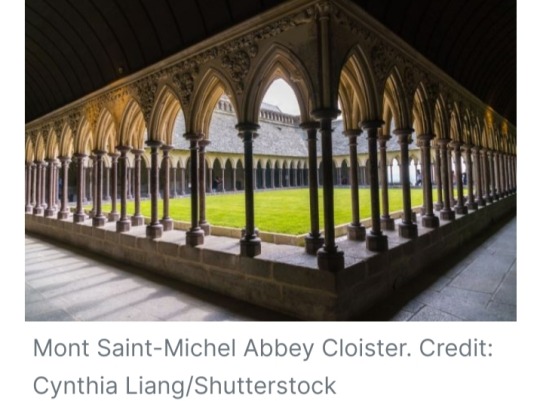
Another highlight of the many celebrations taking place over the summer and part of the autumn will be the “Millennium Solstice,” a never-before-seen light show projected onto Mont Saint-Michel from various spots in the bay on the evening of June 23.
The beauty of this sacred site, trodden by millions of pilgrims over the centuries, has been celebrated and immortalized in the writings of many great men of letters over the last few centuries, from Gustave Flaubert to Théophile Gautier and Victor Hugo.
In particular, it inspired the novel “Les Merveilles du Mont Saint-Michel” (1879) by the prolific writer Paul Féval.
He had already paid tribute to the monument a few years earlier, in “La Fée des grèves,” with these lines often quoted by admirers of the famous Mont:
“Twilight broke. Mont-Saint-Michel was the first to emerge from the shadows, offering the golden wings of its archangel to the reflections of the dawning dawn; then the sides of Normandy and Brittany lit up in turn.
Then again, a sort of light steam seemed to rise from the receding sea, and all was veiled except for the statue of Saint Michael, which dominated this wide ocean of mist.”

#Mont Saint-Michel#Khéops of the West#Victor Hugo#UNESCO World Heritage Site#pilgrimage#St. Aubert#Revelation#Mont-Saint-Michel-au-péril-de-la-Mer#Richard I#Duke of Normandy#La Demeure de l’Archange#The Archangel’s Abode#Millennium Solstice#Gustave Flaubert#Théophile Gautier#Paul Féval#Les Merveilles du Mont Saint-Michel#La Fée des grèves#St. Michael the Archangel
16 notes
·
View notes
Text
Dragon Awakening
There are 13 Dragon Beings that are enveloped in the Earth crust, that have been here for eons of time as Guardians of the Ley Lines, ready to awaken and protect the Christ Child once the Cosmic Dragon births the Golden Dragon Egg and it hatches or cracks open. They have remained asleep in the Earth until the tipping point of global awakening occurs when the Mother of Dragons returns as her fullest divine emanation in her Cosmic Mother Christos Sophia Dragon body. The 13 primary Dragon beings serve as massive energy reservoirs for transmitting an assortment of vital forces and golden fire elementals through their dragon breath, transmitting beautiful shimmering liquid plasma fire waters, living light codes, spiritual vapors, divine aether and pearlescent substances from the Eye of God into the ley lines. Each of the Dragons embody their own astrological correspondence or cosmological principles that interact directly with the main ray creation system located in Ursa Major. We could say that the Cosmic Christos Suns send forth their ray principles and astrological correspondences through the 13 primary Dragon bodies enmeshed within the planetary matrix, so they can release these solar consciousness frequencies and geomantic codes into the layers of the Albion Lightbody.
The Mother of Dragons is the original Cosmic Dragon which oversees the four dragon realms in the middle world, inner world, outer world and core of creation domains that make up the entirety of the Universal, Galactic and planetary consciousness. The Cosmic Mother Dragon also oversees the millions of dragon eggs that are intended for activating the lightbody of human beings and for the spiritual benefit of the various species existing on the planet. We have noted that the Cosmic Mother Dragon is also overseeing the functions of the gatekeeper Dragon being that was in the middle world domains of the Universal Mother Dark Matter Matrix.
Approached with divine respect, reverence and a loving heart, earthly Landscape Dragons are benevolent but as awakening protectors they are fiercely powerful as the untamed natural forces of the Earth. There are many more planetary landscape dragons and astrological dragons with assorted purposes that are located all over the planet to be discovered on the next stage of our awakening journey. Some of them appear to have massive golden bodies with crystal eyes that appear as a variety of colored jewels or gemstones. At this time eight of the primary 13 Dragon beings in the planet have been brought into awareness as the Easter event activates the Saint Michael Line. This begins a Dragon Awakening at the intersection points that are made between Saint Michael Mount in Cornwall, England and Mont-Saint-Michel on the Apollo line in France.
The unification of these Dragon Lines generates new geomantic expressions as it undergoes the solar heart twinning of rhomboid diamond grid patterns into a global hierogamic union event. This new planetary activation comes with the restoration of the Triple Solar Christ Mary in her Universal Ankh Rose Body which produces sacred marriage with the Triple Solar Masculine Christ united through Melchizedek-Metatron-Michael. Their Christos-Sophiaoffspring is a massive Cosmic Dragon Egg that when hatched, will initiate in the grids a powerful pineal-pituitary integration referred to as the Pearl Activation. The Dragon Awakening is happening in the following areas of the planetary grid.
#dragondreamers#dragonawakening#yearofthedoagon#metaphysicalpistol#oraclemine#godsovereignfree#jeminthehologram#ascensionglossary#ascensionmechanics#energeticsynthisis#gsf#ascension
3 notes
·
View notes
Text

Sacra di San Michele - ITALIA
#sacra#san michele#abbey#saint michael#abadia#san miguel#mount pirchiriano#sant'ambrogio#torino#turin#piedmont#italia#italy#europe#europa
74 notes
·
View notes
